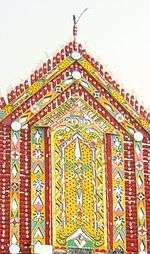Saltigue
| Part of a series on |
| Serers and Serer religion |
|---|
  |
|
Deities |
|
Main doctrines |
|
Sacred places
|
|
Notable figures
|
|
Relations with other religions |
|
Education |
|
See also
|
|
 | |
|
Royal titles | |
| Lamane (also religious) | |
| Maad a Sinig | |
| Maad Saloum | |
| Teigne | |
| Lingeer | |
| Line of succession | |
| Buumi | |
| Thilas | |
|
Religious titles | |
| Saltigue | |
Saltigue, sometimes spelt Saltigué or wrongly Saltigui, are Serer high priests and priestesses who preside over the religious ceremonies and affairs of the Serer people, such as the Xoy ceremony, the biggest event in the Serer religious calendar. They usually come from ancient Serer paternal families. Such a title is usually inherited by birthright.[1][2] The term "Saltigi" is also adopted by the Fula people. They were the leaders of the Fulas in some Fula areas, belonging to the Denianke Dynasty of the Empire of Great Fulo founded by Koli Tengella Bâ in the 16th century.[3] It is proposed that the word "Saltigi", used in reference to the Fulas, comes from the Mandinka language, in which it means "master of the road", used in reference to their neighbors who are Fulani herders and tenders of the flock, the traditional activity of Fulani leaders.[4] In Serer country, Saltigue, not to be confused with Saltigi, are always diviners. In Wolof areas, they were the assistant chiefs.[5] The scope of this article deals only with Saltigue or Saltigué - "diviners" (the high priests and priestesses) and termed by some scholars as "the ministers of the religious cult";[6] "pastors of the people"[7] or within the remits of these definitions.
Role of Saltigues
The Saltigues were advisers to Serer governments, for example in the old Serer Kingdoms of Sine, Saloum and Baol. Their principal role was and still is for the prosperity of the country. In this role, they were responsible for predicting the future of kings; the weather to come (for the purposes of agriculture); any natural disaster or political catastrophe that could befall the country; etc. As such, they were frequently consulted by the Serer kings (Maad a Sinig and Maad Saloum)[8] preferably at the beginning of the rainy season.[9]
Before a king launches a war against another kingdom, or to repel an attack from another kingdom, the king consults the great assembly of Saltigues to predict the outcome of the battle, as was the case of Saltigué and Diaraf Wassaly Sene and Saltigué Laba Diene Ngom at the Battle of Fandane-Thiouthioune (18 July 1867), commonly known as the Battle of Somb, during the reign of Maad a Sinig Kumba Ndoffene Famak Joof.[10][11][12][13] The assembly of Saltigues will predict the outcome, offer precautionary advice on when to launch the attack, the route to take to the battlefield and the animals to be sacrificed, etc. The role of Saltigue was not political. They are not government ministers or politicians, but spiritual advisors and elders. They are the Serer hereditary "Rain priests" - guardians of the Serer religion and customs, a birthright they inherited from their ancient Lamanic ancestors.[14]
In the precolonial period, during the Raan Festival[15] which takes place in Tukar annually on the second Thursday after the onset of the new moon in April, the kings (during the Guelowar period[16]) will attend the Raan Festival of Tukar, making their way from the capital (Diakhao). However, the king was extremely careful never to arrive before the Lamane[17] and always avoid direct encounters with the Lamane of Tukar. Whilst the Lamane was busy self-meditating, touring Tukar and making offerings to the pangool Jegan Joof, the Chief Saltigue and his associates drink sum-sum alcohol all morning before the Festival. It is reported that drinking sum-sum improves the Saltigue's vision of the future and the supernatural world.
Having prepared himself sufficiently, the Saltigue and his close associates leave the house and mount their horses, then start their own tour of some of the sacred places of the country. The Saltigué's tour is programmed to follow the king, but ultimately to cross his path at a location known as 'Nenem". In this location, the king, aware that the Saltigue is coming, stops the royal entourage. The king and the royal entourage must wait for the Saltigue and his companions to pass. After these high priests and priestesses have passed, the king then gives the signal to the royal entourage to pass as they proceed to their next destination. This is the kind of respect that is afforded to the Saltigue.[18] Scholars like Alioune Sarr note that Saltigues are famously celebrated and respected in Serer Kingdoms because of their knowledge.[19]
Serer and Lebou healing methods
The Lebous share many cosmo-spiritual beliefs with the Serers. Many Lebou rab (genie) are actually Serer pangool (Serer ancestral spirits or Saints). The sacred dwelling place of the Lebou rab is the same as the Serer pangool called Sangomar, based on the ancient Serer and Diola legend of Jambooñ and Agaire.[20] – two young sisters whose boat split into half around the Point of Sangomar. One sails to the north, the other sails south. Those traveling south became the ancestors of the Diolas and the other became the ancestor of the Serers. The healing method of the Lebou is called ndepp while the Serer healing method is called Loup.[21][22][23][24][25]
See also
Notes
- ↑ Henri Gravrand. La Civilisation Seereer. Pangool. Published by Les Nouvelles Edition Africaines du Senegal (1990). ISBN 2-7236-1055-1
- ↑ Kalis, Simone, "Medecine Traditionnele Religion et Divination Chez Les Seereer Siin du Senegal", L'Harmattan (1997), pp 11-297, ISBN 2-7384-5196-9
- ↑ M. Th. Houtsma. E. J. Brill's first encyclopaedia of Islam 1913–1936. BRILL. ISBN 90-04-08265-4. p 663
- ↑ Mwakikagile, Godfrey, Ethnic Diversity and Integration in the Gambia: The Land, the People and the Culture. ISBN 9987-9322-2-3. p163
- ↑ Klein, Martin A., Islam and Imperialism in Senegal Sine-Saloum, 1847–1914, Edinburgh University Press (1968) p 262
- ↑ University of Texas at Austin. African and Afro-American Studies and Research Center, University of Texas at Austin. African and Afro-American Research Institute, African Studies Association. African Literature Committee, Modern Language Association of America. African Literatures Seminar, African Literature Association, Modern Language Association of America. African Literatures Division. "Research in African literatures, Volume 24". African and Afro-American Studies and Research Center, University of Texas [at Austin], 1993. p 97
- ↑ Diouf, Marcel Mahawa, Lances mâles: Léopold Sédar Senghor et les traditions Sérères, Centre d'études linguistiques et historiques par tradition orale, 1996. The University of Michigan. p 14
- ↑ In the Serer language, Maad and very rarely used Maat (though correct) means "king" i.e. Maad a Sinig (King of Sine), Maad Saloum (King of Saloum). The Lamanes, - the ancient Serer kings and landed gentry, should not be confused with the post-Guelowar Lamanes who were merely the landed gentry and provincial chiefs answerable to the king. There are two types of Lamanes in Serer chronology : Lamanes pre-Guelowar (the original Lamanes, kings and landowners) and Lamanes during and after the Guelowar period (1350–1969) (mere chiefs and landowners)
- ↑ Sarr, Alioune, Histoire du Sine-Saloum, Introduction, bibliographie et notes par Charles Becker, BIFAN, Tome 46, Serie B, n° 3-4, 1986–1987. p31
- ↑ Sarr, Alioune . Histoire du Sine-Saloum. Introduction, bibliographie et notes par Charles Becker, BIFAN, Tome 46, Serie B, n° 3-4, 1986–1987. pp 31-38
- ↑ Diouf, Mahawa, L'information Historique: L'exemple du Siin. Ethiopiques n°54 revue semestrielle de culture négro-africaine. Nouvelle série volume 7 2e semestre 1991
- ↑ Diouf, Niokhobaye, Chronique du Royaume du Sine, IFAN, commenté par Charles Becker & Victor Martin (1972)
- ↑ Klein, Martin A., Islam and Imperialism in Senegal Sine-Saloum, 1847–1914. Edinburgh University Press (1968), p 91
- ↑ Sarr, Alioune,, Histoire du Sine-Saloum, Introduction, bibliographie et notes par Charles Becker, BIFAN, Tome 46, Serie B, n° 3-4, 1986–1987. p31
- ↑ See Serer religion for Raan Festival.
- ↑ In Serer history and chronology, the Guelowar period starts from 1350 during the reign of Maad a Sinig Maysa Wali Jaxateh Manneh - the first Guelowar king to reign in Serer country i.e. the Kingdom of Sine and ends in 1969 following the deaths of Maad a Sinig Mahecor Joof and Maad Saloum Fode N'Goye Joof, king of Sine and Saloum respectively.
- ↑ These should not be confused with pre-Guelowar Lamanes, who were the kings and landowners (the landed gentry among the old the Serer noble classes).
- ↑ Galvan, Dennis Charles, The State Must Be Our Master of Fire: How Peasants Craft Culturally Sustainable Development in Senegal. Berkeley, University of California Press ( 2004). pp 202-204
- ↑ Sarr, Alioune, Histoire du Sine-Saloum, Introduction, bibliographie et notes par Charles Becker, BIFAN, Tome 46, Serie B, n° 3-4, 1986–1987. p31
- ↑ Many variations of spelling especially Agaire. Sometimes spelt Ageen, Ougeney, Eugene, etc. Jambooñ is sometimes spelt Jambon, Jambonge, etc. Fata Ndiaye in Ethiopiques (French) Le SIIN avant les Gelwaar
- ↑ The Cosaan Foundation
- ↑ Ecole pratique des hautes études (France). 6. section: Sciences économiques et sociales. Cahiers d'études africaines, Volume 46, Issues 181-184. Mouton (2006). p 922
- ↑ Schwarz-Bart, Simone & Schwarz-Bart, André, In Praise of Black Women: Modern African women, Translated by: Rose-Myriam Réjouis, Val Vinokurov. Univ of Wisconsin Press, 2003. ISBN 0-299-17270-8. p62.
- ↑ Taal, Ebou Momar, Senegambian Ethnic Groups: Common Origins and Cultural Affinities Factors and Forces of National Unity, Peace and Stability. 2010
- ↑ Wright, Donald R, Oral Traditions from the Gambia: Family elders. Ohio University Center for International Studies, Africa Program, 1979. ISBN 0-89680-084-9. pp 48-189